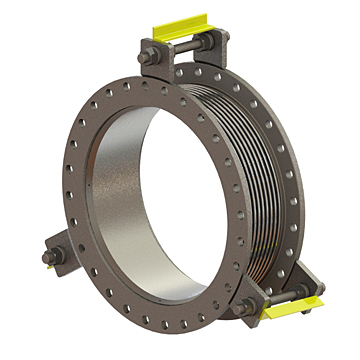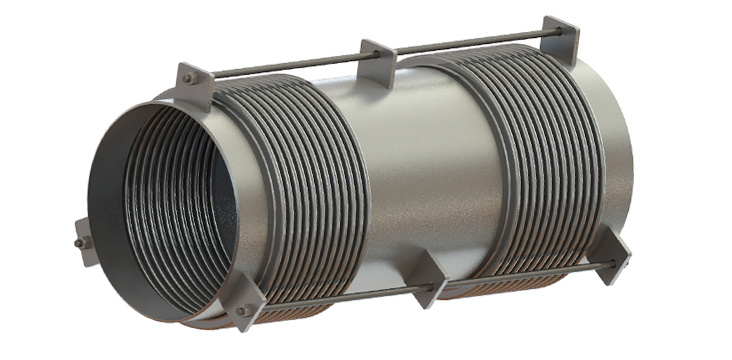Tied Expansion Joints
Single Tied Expansion Joint

The tied expansion joint (EJ) consists of a bellows element attached to end fittings with threaded rod or bar hardware traversing the bellows element. The tie rods are attached to lugs or rings that limit the length of the EJ. The tie rods and the attachment hardware are designed to contain pressure thrust.
Tied expansion joints are designed to have a fixed overall length. The tie rods are attached in a way that eliminates axial movement and forces the ends of the EJ to remain parallel at all times. This configuration allows for only two degrees of freedom, lateral in two axes.
Movement Capabilities
In a single tied EJ the hardware generally limits the movement to two degrees of freedom, lateral deflection in two axes. The tie rods and hardware are designed to contain pressure thrust so external main anchors are not required. However, deflection spring forces must be accommodated by the system designer.
There is a special configuration that uses just two tie rods. This configuration allows for three degrees of movement, lateral in two axes and angular about one axis.
Universal Tied Expansion Joint

If a large lateral offset is required a tied universal EJ is an appropriate choice. In this case there are two identical bellows elements separated by a center spool with tie rod hardware traversing both bellows elements. To accommodate lateral offset each bellows element tilts. The tied universal EJ can support two degrees of motion, just like the tied single EJ.
The amount of lateral offset is only limited by the distance between the bellows elements and the overall length of the assembly. The separation of the bellows elements also results in a very low lateral offset spring rate.
As with the single tied EJ, if just two tie rods are used, the configuration allows for three degrees of movement, lateral in two axes and angular about one axis.
Features of Tied Design:
- Simple design, Relatively low cost
- The universal configuration can be designed with a very low lateral spring rate and high lateral movement capacity
- Versatile and common throughout all industries
- Two degrees of movement capability for tied single or universal design
- Three degrees of movement for two tie rod design
- Tie rods contain pressure thrust
Benefits of tied design:
- Pressure thrust is accommodated by hardware, external anchorage is only required for spring forces
- Can be designed with very low lateral spring rate
Universal Tied Expansion Joint with Limit Rods

In some cases it is useful to limit the length of an EJ while allowing it to accept axial compression and angular movement in addition to lateral offset. This is called an EJ with limit rods. In the single and universal designs, the EJ with limit rods can accommodate angular movement, just like an unrestrained EJ.
Even though the hardware is designed to contain pressure thrust, the system designer must accommodate pressure thrust with external anchorage if axial movements are applied. As soon as the expansion joint begins to compress or tilt, pressure thrust will no longer be handled by the tie rod hardware.
Features of Limit Rod Design:
- Simple design, Relatively low cost
- The universal configuration can be designed with a very low lateral spring rate and high lateral movement capacity
- Versatile and common throughout all industries
- Five degrees of movement capability for single or universal design
- Tie rods and hardware are designed for pressure thrust but external anchorage is required to contain spring forces and pressure thrust in service
Benefits of Limit Rod Design:
- Hardware is can be relied upon to contain pressure thrust in the event of failure of a piping anchor
- Can be designed with very low lateral spring rate
Applications:
The Tied EJ is appropriate for any application where movement can be limited to lateral offset in two axes. Since pressure thrust is handled by the tie rod hardware, external anchorage is only required to handle spring forces. Where very low lateral spring rate is required, the tied universal configuration is the best solution.
It is also worth noting that the thermal growth between the tie rod anchor points is imposed on the bellows elements as internal axial movement.
That means that the axial growth of the piping between the tie rod anchor points can be ignored by the piping designer. This can be a very significant applications issue on high temperature designs and large diameter pipe systems.
The limit rod EJ is appropriate for any application that could accommodate an unrestrained expansion joint. However, since the limit rod hardware is designed for pressure thrust, the limit rods act as insurance, a safety backup, against loss of external anchorage.
Range of Design & Operating Conditions:
- Full vacuum to 2000 psig depending on size
- Cryogenic to 1600°F
- Sizes from 1” NPS to > 240” NPS
Accessories & Options:
- NDE/QA
- Flow liner
- External cover (Shroud)
- Tie rods/Limit rods/Control rods
- Hinge/Slotted Hinge
- Gimbal
- Ply Testable
- Red-Top©
- Multi-Ply Bellows
- Purging
- Insulation
- End Connections
- 2 Ply Test Kit
- On Site Service
